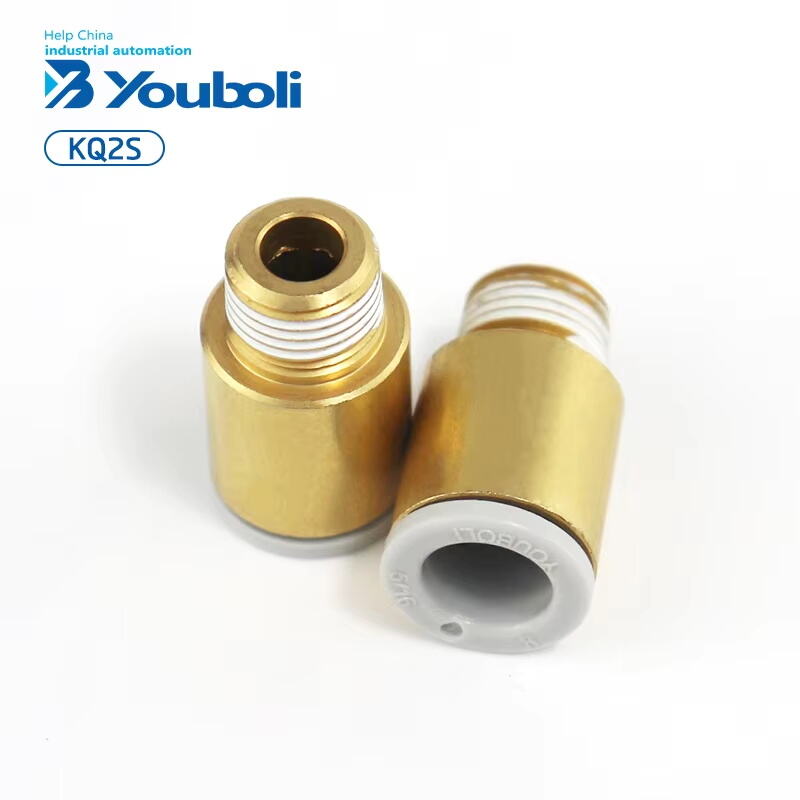The Role of Quick Connect Pneumatic Fittings in Industrial Settings
Quick connect pneumatic fittings play a vital role in many industrial environments, especially on factory floors and production lines. These fittings create smooth connections in pneumatic systems so compressed air and other fluids can move freely between different parts of machinery and equipment. When workers need to switch out tools or adjust system configurations, quick connects save time because they don't require special tools for installation. This reliability means less downtime during regular maintenance or when making adjustments to production processes, which ultimately keeps factories running at full capacity without unnecessary interruptions.
Quick connect fittings really shine when it comes to making work faster and easier. These connectors let workers hook up hoses and tools without all the hassle of traditional methods, saving both time and energy during setup. For anyone working in fast moving settings like manufacturing floors or construction sites, this speed makes a world of difference since every minute counts against production schedules. Plus, good quality fittings create tight seals that prevent leaks, so systems keep running smoothly without unexpected interruptions. This reliability matters a lot in applications where air pressure needs to stay constant throughout operations.
Quick connect pneumatic fittings cut down on downtime quite a bit, which is something that really plagues many factories and plants. The way these fittings are built lets workers hook up and take apart air lines and attachments without needing any fancy wrenches or special gear. Maintenance tasks get done faster this way, and when changes need to happen during operations, everything goes much quicker too. Machines spend less time sitting idle waiting for connections to be made or broken, so production keeps moving along. For businesses looking at their bottom line, this means fewer interruptions in daily operations and ultimately better overall output from their manufacturing processes.
How Quick Connect Fittings Work: Mechanism and Ease of Use
Quick connect fittings work with a simple but really good mechanism that makes connections fast and secure. Most of these fittings come with valves inside that pop open as soon as they're attached, so air or liquid can start flowing right away. What's nice about them is the locking collar design that clicks into position once everything's connected properly. This kind of setup helps prevent mistakes during installation while saving plenty of time when putting things together or taking them apart later on. Mechanics love them because they cut down on those frustrating moments where something doesn't fit quite right.
Operators love how easy quick connect fittings are to work with, often pointing out their comfortable design and how fast they let people hook up or take apart equipment. The comfort factor really matters in busy industrial workplaces where saving time means everything. Think about factory floors specifically these days. Quick connects make the whole process much smoother because workers don't have to fumble around changing tools or hoses between jobs. Productivity goes way up when there's no waiting around for connections. Factories that switched to these fittings report noticeable improvements in their daily output since nobody gets stuck waiting on equipment changes anymore.
Key Benefits of Quick Connect Pneumatic Fittings for Industrial Efficiency
Quick connect pneumatic fittings offer several key benefits that significantly enhance industrial efficiency.
Fast and Easy Installation
Quick connect fittings cut down on installation time quite a bit, and this naturally means faster production overall. Traditional fittings need wrenches and all sorts of tools to get them assembled properly, while quick connects let workers just push and click to make those secure connections. The whole process is so much simpler than dealing with bolts and nuts. For anyone working on an assembly line where every minute counts, these fittings can really make a difference. Factory managers have told me they save hundreds of hours each month just by switching to this type of connection system, which obviously helps keep production numbers looking good without needing extra staff or overtime pay.
Leak-Proof Design
A fitting that doesn't leak makes all the difference when it comes to keeping things running smoothly. When air escapes through faulty connections, pneumatic systems just don't work right because they need proper pressure levels to function properly. Quick connect fittings cut down on this problem by stopping unwanted air loss, which saves money on wasted energy and maintenance expenses. Think about manufacturing plants or assembly lines where every drop counts literally. Small leaks might seem harmless at first glance but actually cost businesses thousands each year in lost productivity and repairs. That's why many industries invest in quality fittings from the start rather than dealing with constant fixes later on.
Improved Safety
Workplace safety gets a real boost from quick connect fittings since they cut down on accident risks tied to manual connections. The old school threading approach needs quite a bit of muscle power, which often leads to sore muscles or even injuries over time. With quick connects there's no need for tools at all, so workers don't have to struggle with tight fittings anymore. This simple change makes a big difference in preventing slips, drops, and other workplace incidents while creating an overall safer atmosphere for everyone on site.
Versatility
Quick connect fittings are pretty much essential for so many industries these days. We're talking everything from cars being built on factory floors to those high-tech labs where medicines get made, plus even textile manufacturing plants. What really sets these fittings apart is how they work with all sorts of equipment setups while handling different kinds of pressure levels and fluid types without breaking a sweat. Take a look at any modern production facility and chances are good there will be quick connects somewhere. They just fit right in whether it's part of an air-powered conveyor belt system or something more complex like transferring corrosive chemicals between tanks. The bottom line? These fittings make operations run smoother because workers don't waste time fumbling with complicated connections when things need to happen fast.
Common Types of Quick Connect Fittings
Quick connect fittings play a big role in pneumatic systems throughout manufacturing plants and workshops everywhere. Among these, Push-to-Connect fittings stand out as favorites among technicians. What makes them so popular? Simple installation without any tools required. Just push the tube into place and it stays put until needed elsewhere. This works great for connecting air lines to various pneumatic equipment on factory floors. The whole point is saving time when switching between different tools during production runs. When maintenance crews need to replace worn parts or adjust setups, they don't waste precious minutes fumbling with wrenches or special adapters.
Threaded fittings have built a solid reputation when it comes to holding up in those tough high pressure situations where nothing less than a rock solid connection will do. The whole idea is simple enough really just twist them into position until snug against whatever surface they need to attach to. What makes these so dependable? Well, they can handle all sorts of rough treatment without coming loose or failing completely during operation. That's why most manufacturing plants and construction sites stick with threaded fittings whenever there's any risk of leaks or unexpected failures down the line. After all, nobody wants to deal with emergency repairs caused by something as basic as a faulty connection point.
Barbed fittings play an important part in setups that need some give and take because they're made specifically for flexible hoses. When installed properly, the barbs on these fittings bite into the inner wall of the hose material, forming what most people would call a pretty good seal against leaks. And let's face it, nobody wants water or whatever fluid running through the system escaping all over the place. That's why plumbers and engineers rely so much on them. These fittings really shine when dealing with situations where the hose isn't going to stay perfectly still all day long. Think about automotive cooling systems or irrigation lines that get bumped around during installation or regular operation.
Compression fittings play a key role when it comes to making sure tubing stays connected properly, particularly in situations where there's a lot of stress on the system. The way these fittings work is pretty straightforward they apply pressure around the connection point, creating something that holds together well without leaking. That's why they're so popular in industrial settings where temperature fluctuations and pressure changes happen all the time. Workers in maintenance departments know from experience that these fittings tend to hold up better under tough conditions compared to other types of connections.
Best Practices for Selecting and Maintaining Fittings
Getting the right fittings sorted out for pneumatic systems really matters if we want everything to work properly and stay safe. First things first, look at what the system actually needs - think about pressure levels, whether materials will play nice together, and what kind of job these fittings need to do. Material compatibility isn't just some technical detail; mismatched materials can actually react badly over time and weaken those connections. Pressure ratings matter too because nobody wants their fittings giving way under stress during operation. A good rule of thumb is to pick fittings rated higher than what's expected in normal conditions. This gives that extra margin of safety everyone hopes for but rarely talks about when things go wrong on site.
Keeping these fittings properly maintained remains just as critical for their long term performance. A good practice involves cleaning them regularly while checking for cracks, corrosion spots, or other forms of deterioration that might cause leaks down the line. These small issues often develop slowly but can eventually compromise entire pneumatic systems if left unchecked. Most technicians recommend monthly inspections at minimum, especially after periods of heavy usage. Proper maintenance not only prolongs fitting life expectancy but also prevents costly downtime when systems fail unexpectedly during production cycles.
FAQ
What are quick connect pneumatic fittings?
Quick connect pneumatic fittings are components used to easily connect and disconnect hoses and equipment in pneumatic systems, facilitating efficient air and fluid transfer.
How do quick connect fittings reduce downtime?
These fittings allow for rapid attachment and detachment without tools, speeding up routine maintenance and adjustments, thus minimizing machine downtime.
Are quick connect fittings safe compared to traditional methods?
Yes, they improve safety by minimizing physical strain and reducing the risk of accidents associated with manual connections and traditional threading methods.
Can quick connect fittings be used in any industrial application?
Yes, their versatility allows them to be used across various industries, including automotive, pharmaceuticals, and textiles, adapting to different systems and pressures.

